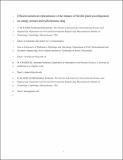| dc.contributor.author | Razmi, Amir Mehdi | |
| dc.contributor.author | Chamecki, Marcelo | |
| dc.contributor.author | Nepf, Heidi | |
| dc.date.accessioned | 2020-08-20T21:25:33Z | |
| dc.date.available | 2020-08-20T21:25:33Z | |
| dc.date.issued | 2019-11 | |
| dc.identifier.issn | 0022-1686 | |
| dc.identifier.issn | 1814-2079 | |
| dc.identifier.uri | https://hdl.handle.net/1721.1/126712 | |
| dc.description.abstract | This study considered a new approach for representing flexible canopies within large-eddy simulation that captures the impacts of reconfiguration on both the canopy posture and the canopy drag. The unsteady change in plant posture in response to the passage of turbulence structures (monami) was assessed using established steady-reconfiguration models responding to the unsteady velocity at the top of the canopy. The new drag and plant posture models improved the modelling of highly flexible canopies by more accurately capturing the observed vertical distribution of peak Reynolds stress. When compared to models that do not consider reconfiguration, or that represent it only through a velocity-dependent drag coefficient, the addition of a velocity-dependent canopy posture (unsteady reconfiguration) achieved up to a 56% reduction of the root mean square error for mean horizontal flow velocity and Reynolds stress profiles over the canopy. The RMSE for turbulence intensities and skewness were reduced up to 48% and 56%, respectively. | en_US |
| dc.language.iso | en | |
| dc.publisher | Informa UK Limited | en_US |
| dc.relation.isversionof | http://dx.doi.org/10.1080/00221686.2019.1671511 | en_US |
| dc.rights | Creative Commons Attribution-Noncommercial-Share Alike | en_US |
| dc.rights.uri | http://creativecommons.org/licenses/by-nc-sa/4.0/ | en_US |
| dc.source | Prof. Nepf via Elizabeth Soergel | en_US |
| dc.title | Efficient numerical representation of the impacts of flexible plant reconfiguration on canopy posture and hydrodynamic drag | en_US |
| dc.type | Article | en_US |
| dc.identifier.citation | Razmi, Amir Mehdi et al. "Efficient numerical representation of the impacts of flexible plant reconfiguration on canopy posture and hydrodynamic drag." Journal of Hydraulic Research (November 2019): dx.doi.org/10.1080/00221686.2019.1671511 © 2019 International Association for Hydro-Environment Engineering and Research | en_US |
| dc.contributor.department | Massachusetts Institute of Technology. Department of Civil and Environmental Engineering | en_US |
| dc.contributor.department | Parsons Laboratory for Environmental Science and Engineering (Massachusetts Institute of Technology) | |
| dc.relation.journal | Journal of Hydraulic Research | en_US |
| dc.eprint.version | Author's final manuscript | en_US |
| dc.type.uri | http://purl.org/eprint/type/JournalArticle | en_US |
| eprint.status | http://purl.org/eprint/status/PeerReviewed | en_US |
| dc.date.updated | 2020-08-19T17:25:56Z | |
| dspace.date.submission | 2020-08-19T17:25:58Z | |
| mit.license | OPEN_ACCESS_POLICY | |
| mit.metadata.status | Complete | |
